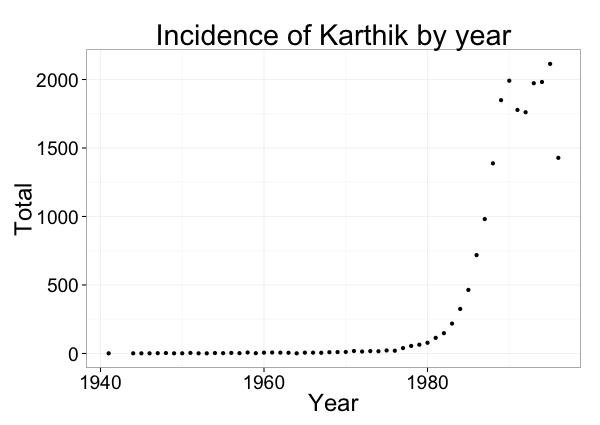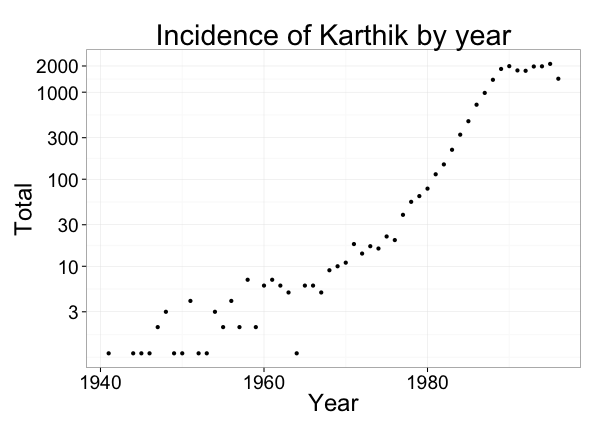Most people not from South India have trouble understanding South Indian names. What sets South Indian names (talking primarily about Tamilian, Malayali and South Interior Kannadiga names here) apart is that they are patronymic, with the one’s father’s or husband’s given name ending up as your last name. There is no concept of surnames here, and names don’t travel generations. Sometimes you have the name of the native village or the ancestral profession as part of the name, but the latter was all but dropped from most names following the “anti-surname revolution” championed by Periyar EV Ramaswami (formerly Naicker) in Tamil Nadu.
Let me give you some examples of South Indian names before I proceed to propound my theory. Till the time I was twenty two, I was alternately known as “S Karthik” and “Karthik S” – the order of words in South Indian names don’t matter that much. “Karthik” is my given name. The “S” stands for “Shashidhar”, which is my father’s given name. Then, at the age of twenty two I happened to use my passport for the first time. And was faced with an employer who didn’t understand South Indian names, and so expanded my name to its “passportized form” – “Karthik Shashidhar”. My given name as my “first name” and my father’s given name as my “last name”.
Not everyone’s names are passportized the same way, though. My father, for example, had Shashidhar, which was his given name as his “last name” in the passport. His “given names” (as his passport described them) were “Gollahalli Suryanarayana Rao”, Gollahalli being my father’s native village and Suryanarayana Rao being his father’s given name. Notice that the word “Rao” was an honorific and not a surname and didn’t transcend generations. For the record, my father’s father’s father was Gollahalli Venkataramana Shastri and his father was Gollahalli Annadaana Bhat. I’m mentioning this here just to show you that till recently even words like “Shastri” and “Bhat” were honorifics added to one’s name based on one’s profession and didn’t transcend generations (my grandfather was ineligible for the honorific “Shastri” since he wasn’t a priest). Based on the names of my ancestors as I’ve written here, you might jump to the conclusion that “Gollahalli” can be seen as my family name, but then my father in his infinite wisdom decided that it didn’t deserve to be part of my name since 1. I’ve never been there and 2. It doesn’t sound good (it translates to “village of shepherds”).
Now that this short personal history is behind us, let me explain to you how patronymic South Indian names work. First of all, you need to take in to account that unlike most other parts of the world (primarily Europe) there has never been a law in South India that dictates what form one’s name should take (for example, in the 1930’s Mustapha Kemal (later Pasha) passed a law that forced all Turks to have surnames that transcended generations patrilineally). In agrarian economies where your entire network is not large, you don’t need too many words in your name to distinguish you. So most people simply went around with one name. Then, as networks expanded and people started migrating, they started prefixing the names of their native towns to their names – that was seen as some sort of qualifier. Then, for reasons I don’t completely comprehend, sometime in the middle of the last century, it became customary to add one’s father’s name as one of the words in your own name (notice how my grandfather and his ancestors did not include their fathers’ names as part of their names. But my father did). It could do with urbanization when from each town there was a considerable number of people with the same given name so adding one’s father’s name had to be used for discrimination.
Thus, by the middle of the 20th century, one pattern of South Indian patronymic names became dominant – among both men and women. <Village Name> <Father’s given name> <Own given name>. Like Gollahalli Suryanarayana Rao Shashidhar or Holenarasipura Ramaswamy Prabha. Things were not so simple, though, since a woman was required to change her name to include her husband’s after marriage. In rural areas, women typically used only one name so this wasn’t so much of a problem (my father’s mother still uses only one name which is her given name). In urban areas, where it was customary to have two or more words in a name, some women simply added their husbands’ given names as their last names while others decided to go the <husband’s village name > <husband’s given name> <own given name> format. It was all quite complicated. So complicated that many women in my mother’s generation (including my mother) decided against changing their names after marriage.
The problem with South Indian patronymic names has been that there has never been a particular format that has been allowed to settle. At all points of time in history, there have always been competing formats, and “regulatory”/customary changes have meant that each of these formats have died a quick death. This is the cause of much confusion. However, with increasing globalization and “passportization”, we seem to be getting somewhere close to some sort of a standard format.
As I mentioned a while earlier, I was forced to “expand” my name when I had to apply for my passport, since the passport form doesn’t recognize initials. Going by the way my father had expanded his name I thought I had filled up the application form to indicate my name as “Shashidhar Karthik” but my name ended up there as “Karthik Shashidhar”. While at that point of time it didn’t matter much, the advent of GMail has meant that I’m happy my name is not the other way round – since in conversation view only a person’s first name is shown.
Yet, there are people who have chosen to expand their names the other way, and this is more likely among people in professions where it is customary to refer to someone only by their last name. With most people not wanting to be called by their father’s names, they’ve ordered the words in the names (this needs to be done only when one gets a passport – remember – and for most people that’s when you’ve decided your profession) in a way that their given name actually appears as their last name. For example neither of the cricketers Murali Kartik or Murali Vijay is actually named Murali – both their fathers are named Murali and their respective given names are Kartik and Vijay.
So, looking at what is now turning out to be a standard format South Indian name, how does one figure out what is the person’s given name and what is his father’s name? This is where some cultural understanding helps. About a hundred years ago, South Indian names were quite long (as is evident from the names of my ancestors I’ve published above). With time, however, names are getting progressively shorter. Perhaps a hundred years ago, the set of names given to boys in South India was disjoint from the set given to boys in North India, and the same was true with girls. With increasing globalization and national integration, though, this has changed rapidly over the last century. While some might attribute it to the so-called Nehruvian Hindi Imperialism, the flow has largely been one way, with more South Indians being given what were traditionally North Indian names rather than the other way round (the only North Indian I know with a South Indian sounding first name is Kumar Mangalam Birla, and his name can be explained by the fact that his mother is a native of Madurai).
Because of this cultural integration, over the generations South Indian names have tended to get shorter, because of which you can generalize with a rule that in any given family, it is more likely that a son’s name is shorter than his father’s. So when you look at someone with “two first names” as their name, a general rule of thumb is that the shorter of the two names is their own name and the longer one is their father’s. Based on this rule it is extremely likely that Viswanathan Anand’s given name is Anand, and Hariharan Rahul’s given name is Rahul, never mind the order in which they are written.
We are however now reaching a stage where people with rather short (mono or bi-syllabic) names are becoming fathers and they can’t pick shorter names for their sons, so you have a situation where father and son have names of similar length. Perhaps this is the reason a number of people are resorting to rather unusual names for their kids these days (like Aarav, for example), without realizing that these names are going to become last names one generation hence.
My wife thinks that “Karthik” is a lousy last name, so there have already been many debates about how we should name our children (whenever we have them). I’ve come to the conclusion that the problem with South Indian patronymics is that the father’s name is used as it is and not modified like in other patronymic cultures which is the cause of all this confusion. Going by this principle, I think my kids should have something like “Karthikovitch” or “bin Karthik” as their last name.
As for the names in the title, Swaminathan Ganesh is a friend from college and I’ve included his name because it fails the “length test”. His given name is Swaminathan and his father’s name is Ganesh. For the record, his brother is Krishnamurti Ganesh, another name that fails the length test. I propose that “Swaminathan Ganesh” be the generic terms for individuals from whose names it is impossible to make out which word their given name is.
I’ve talked about Murali Vijay earlier in the post. It’s amusing how most commentators still refer to him as “Murali”.
From time to time I get phone calls asking for “Mr. Shashidhar”. Each time I almost instinctively tell them that it’s been a few years since “Mr. Shashidhar” (my father) died, and then realize they’re asking for me.


